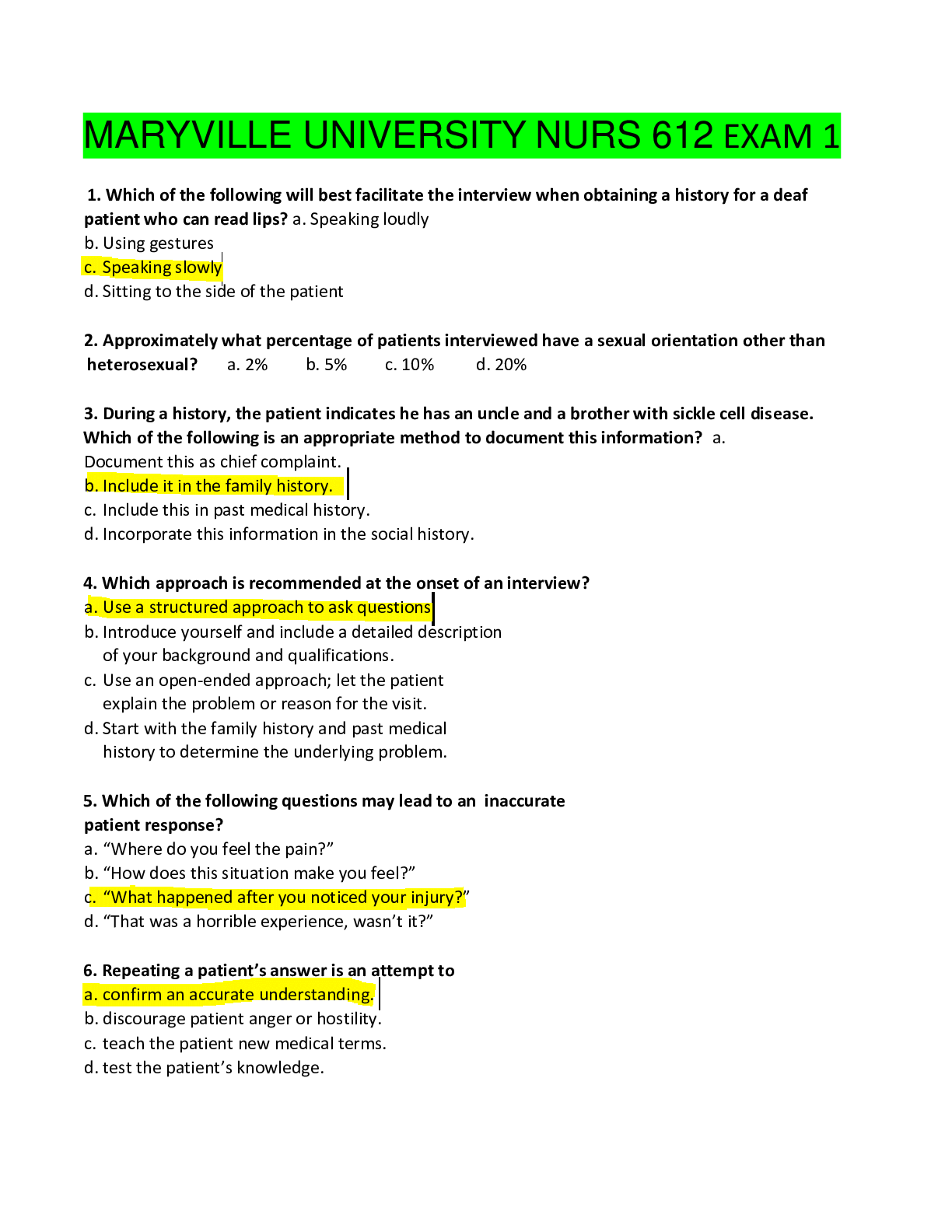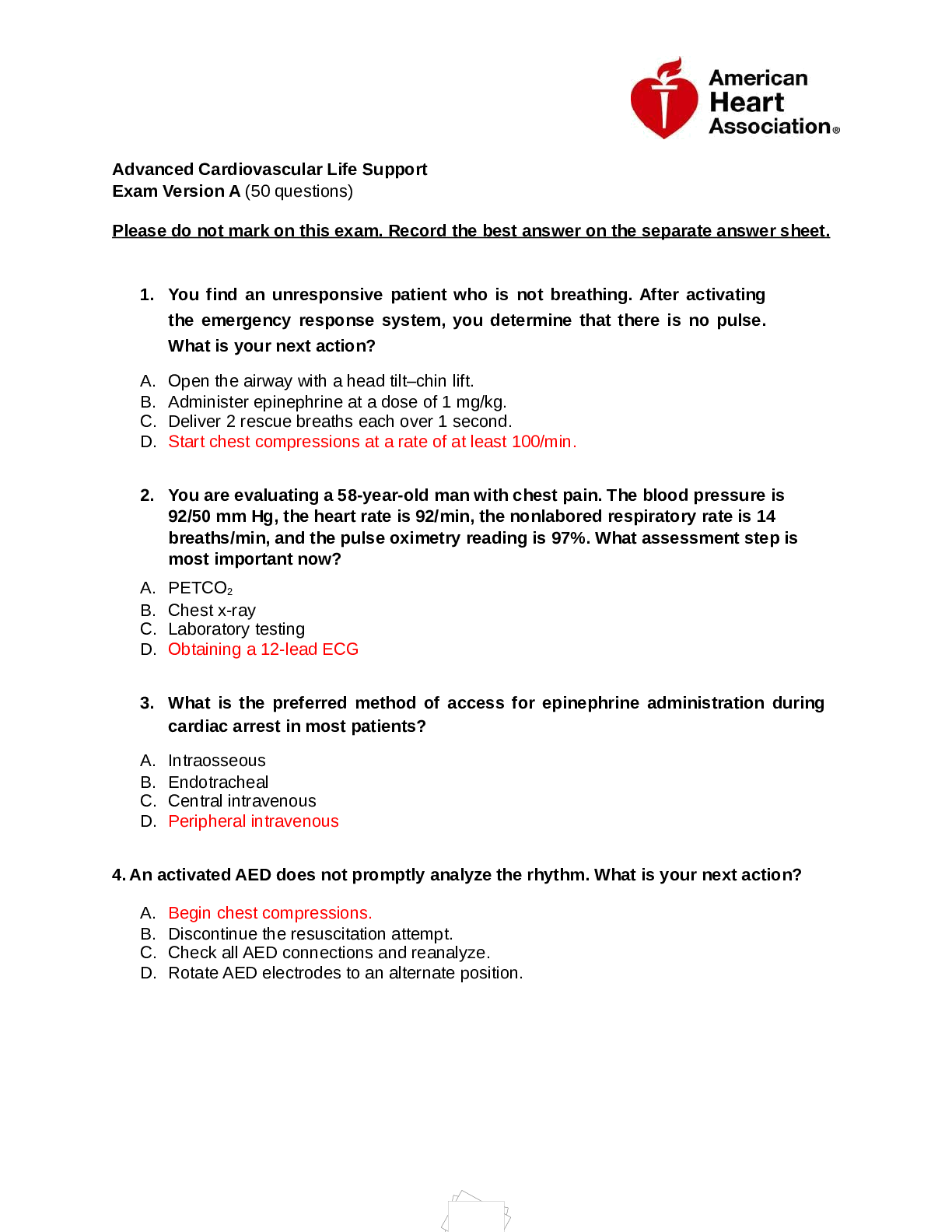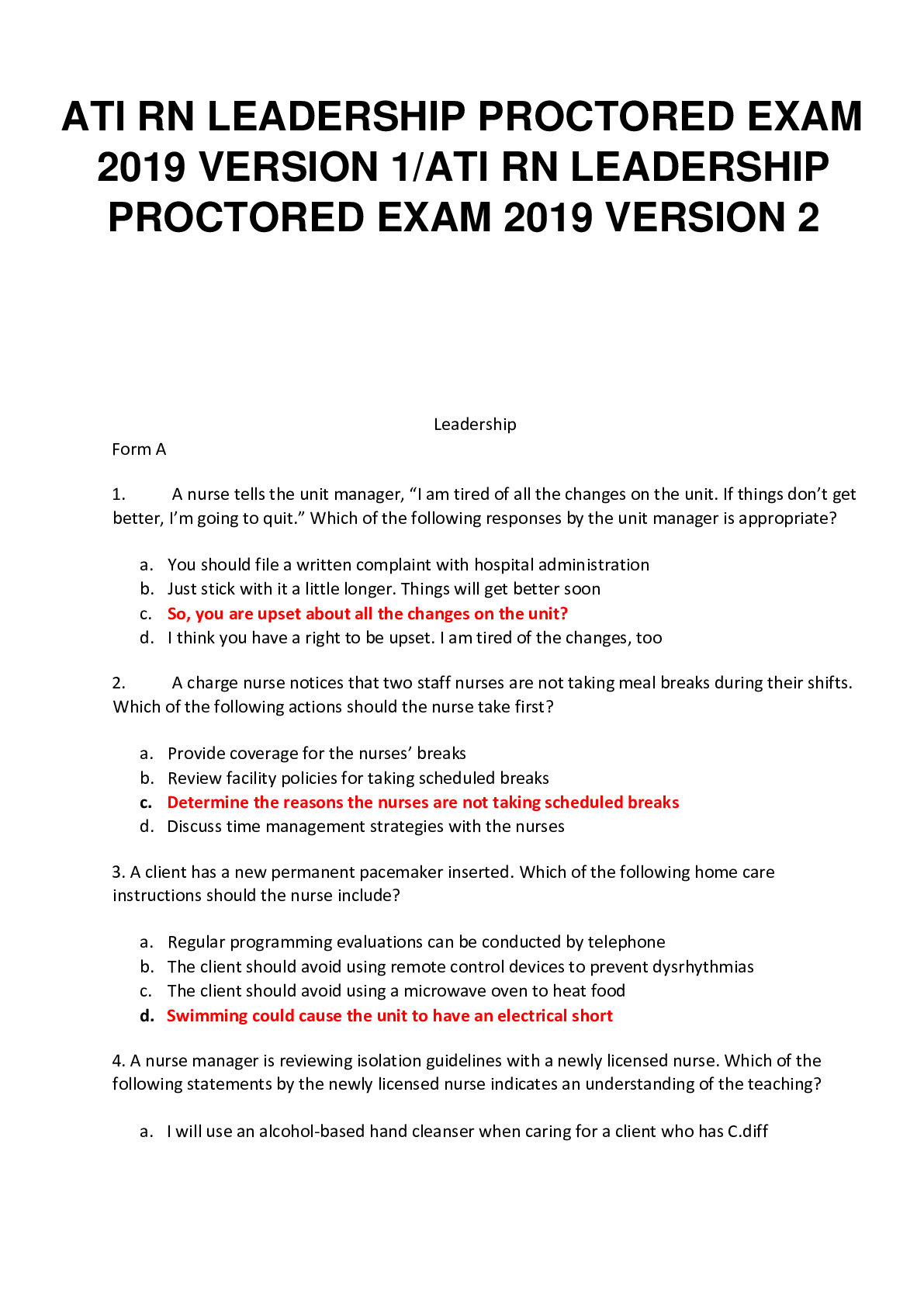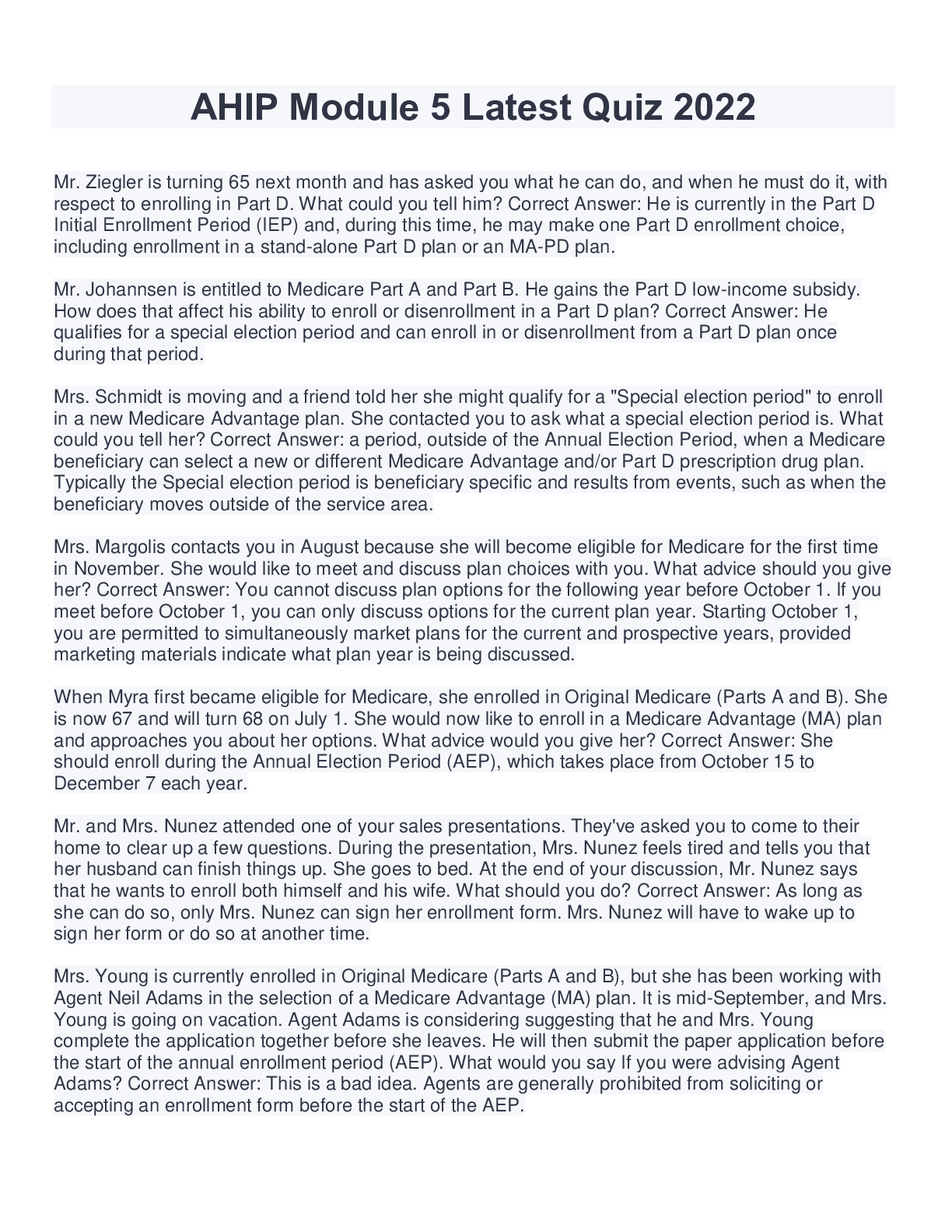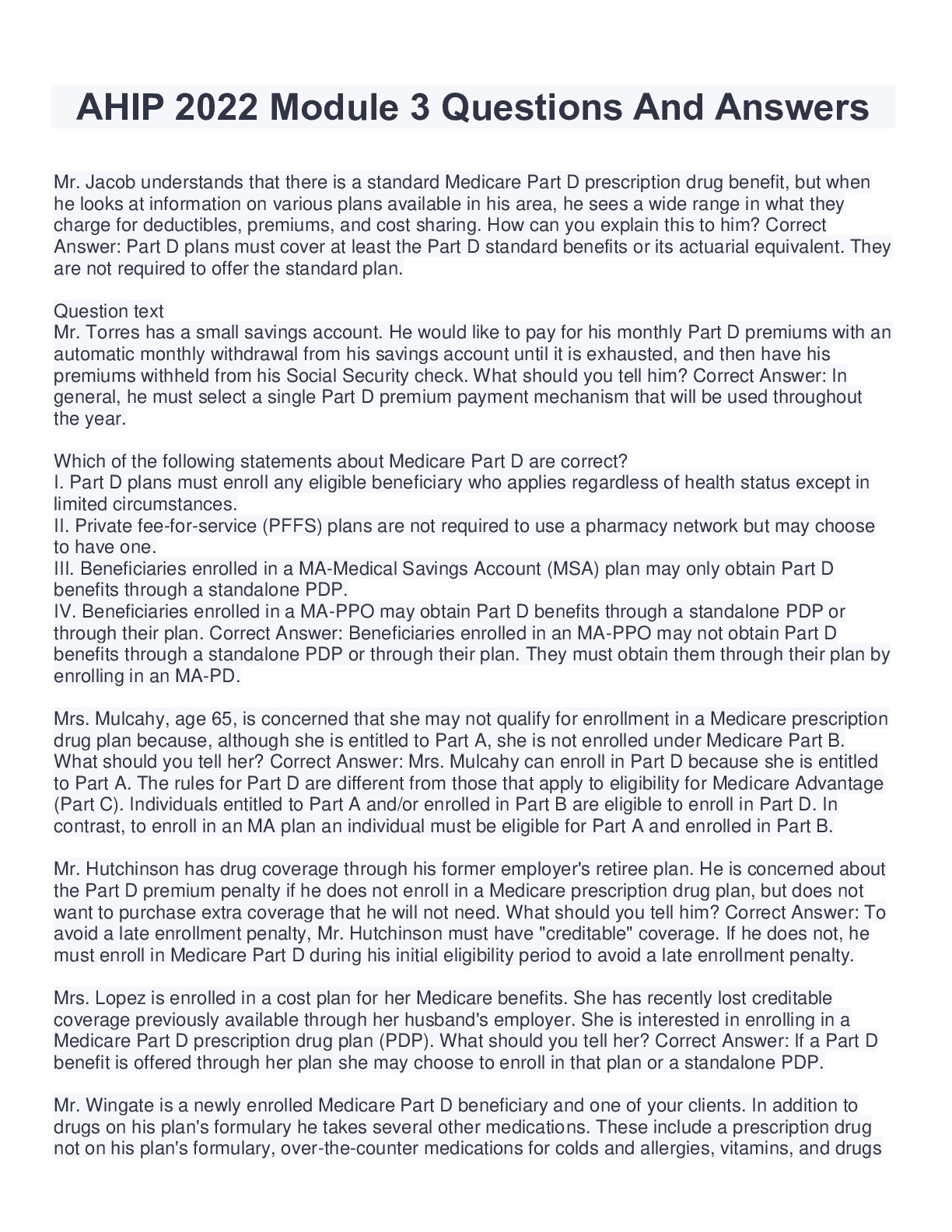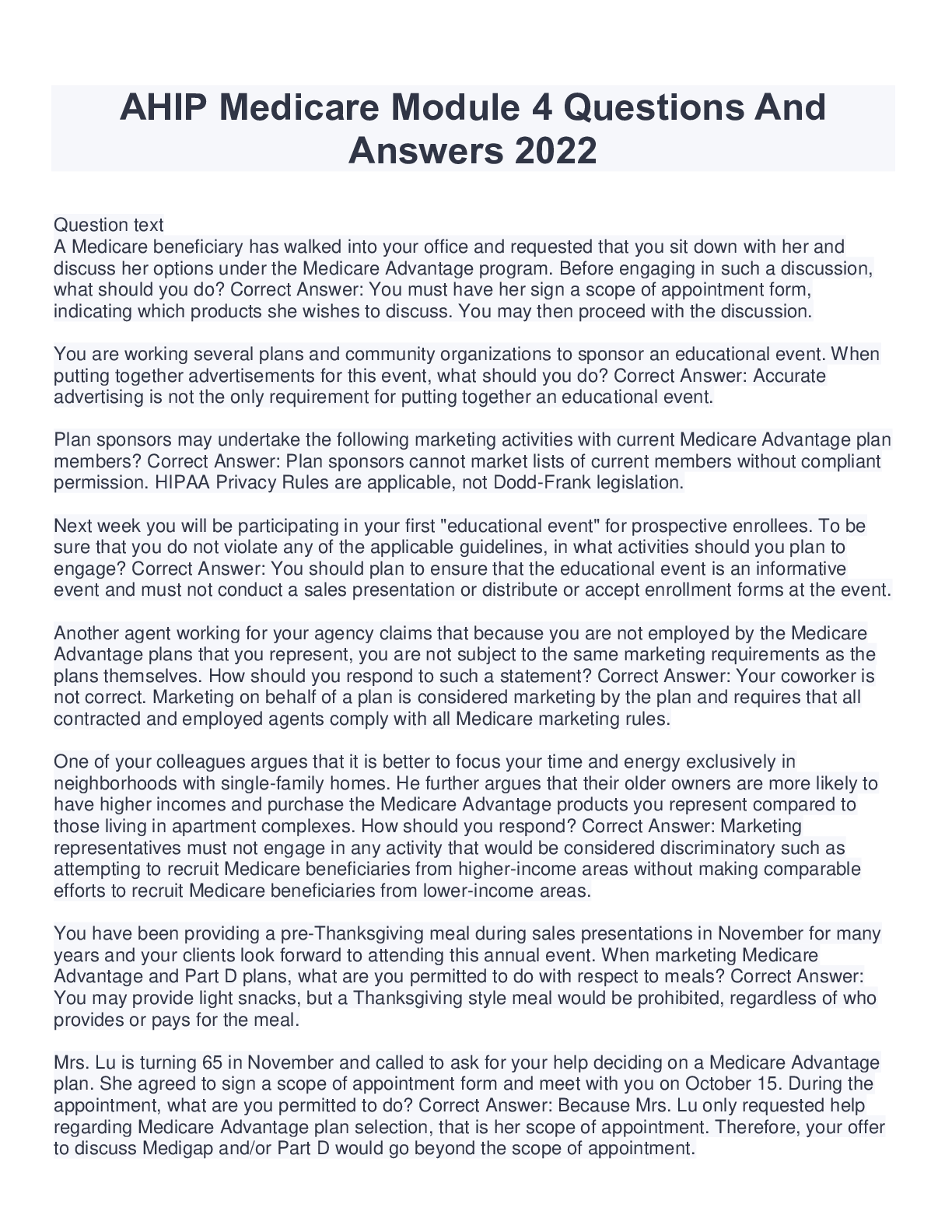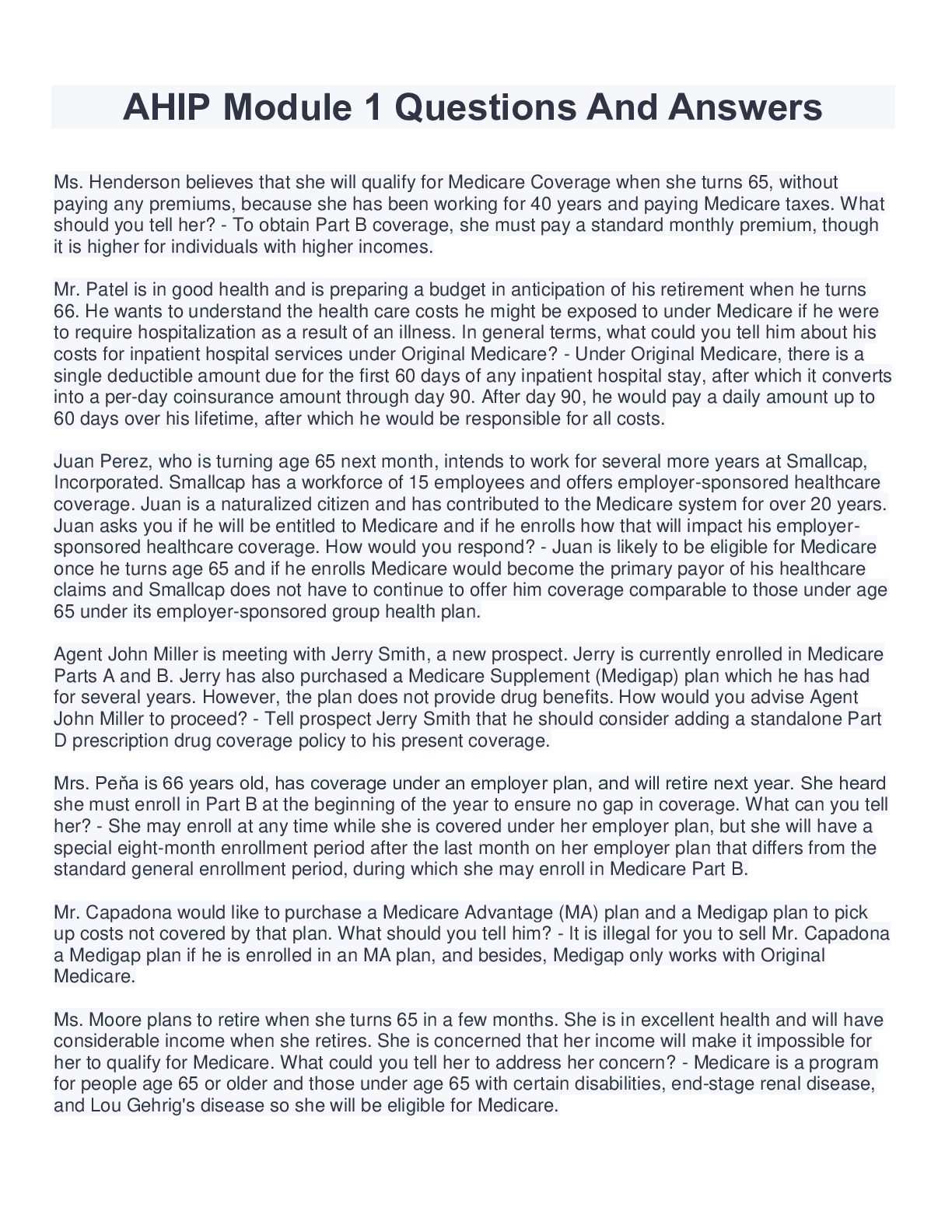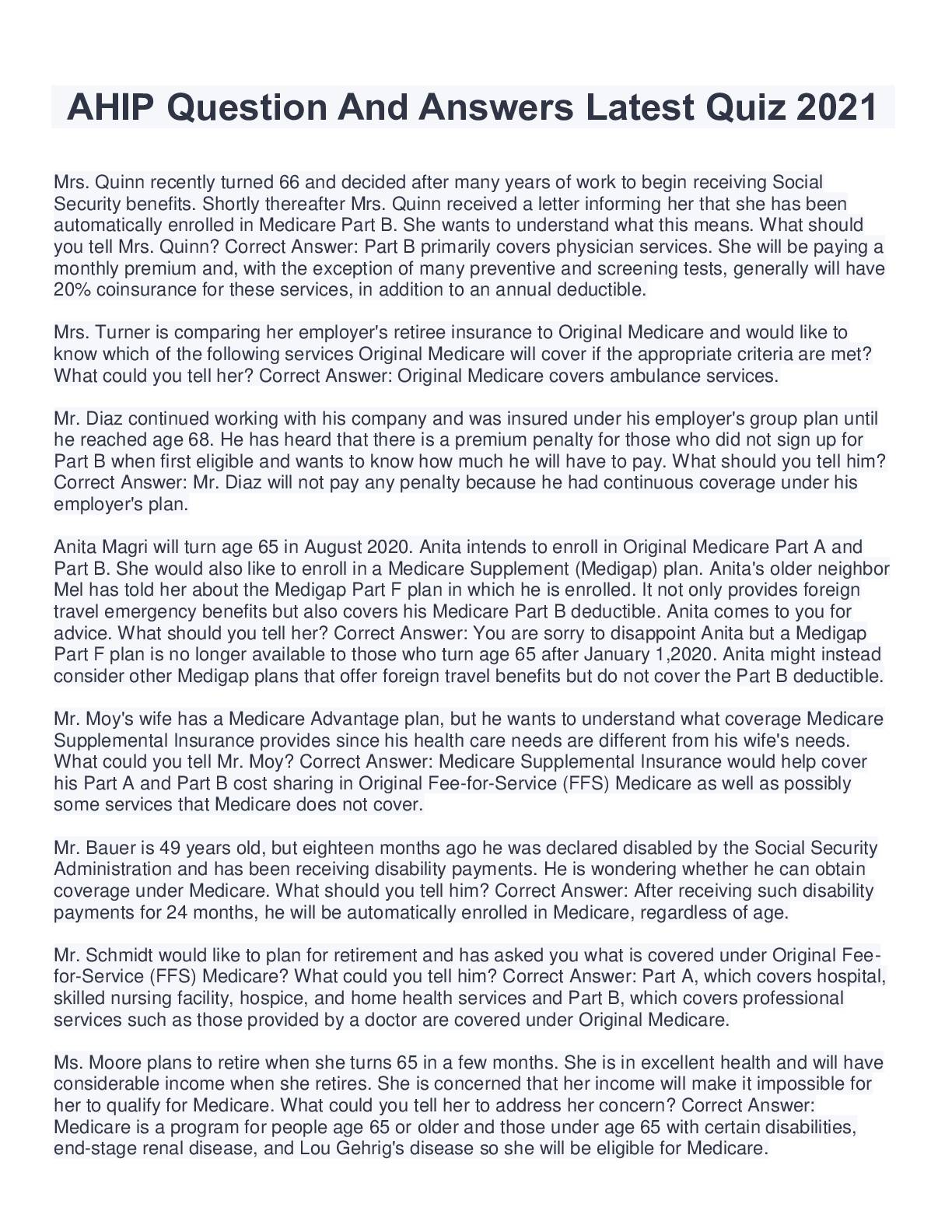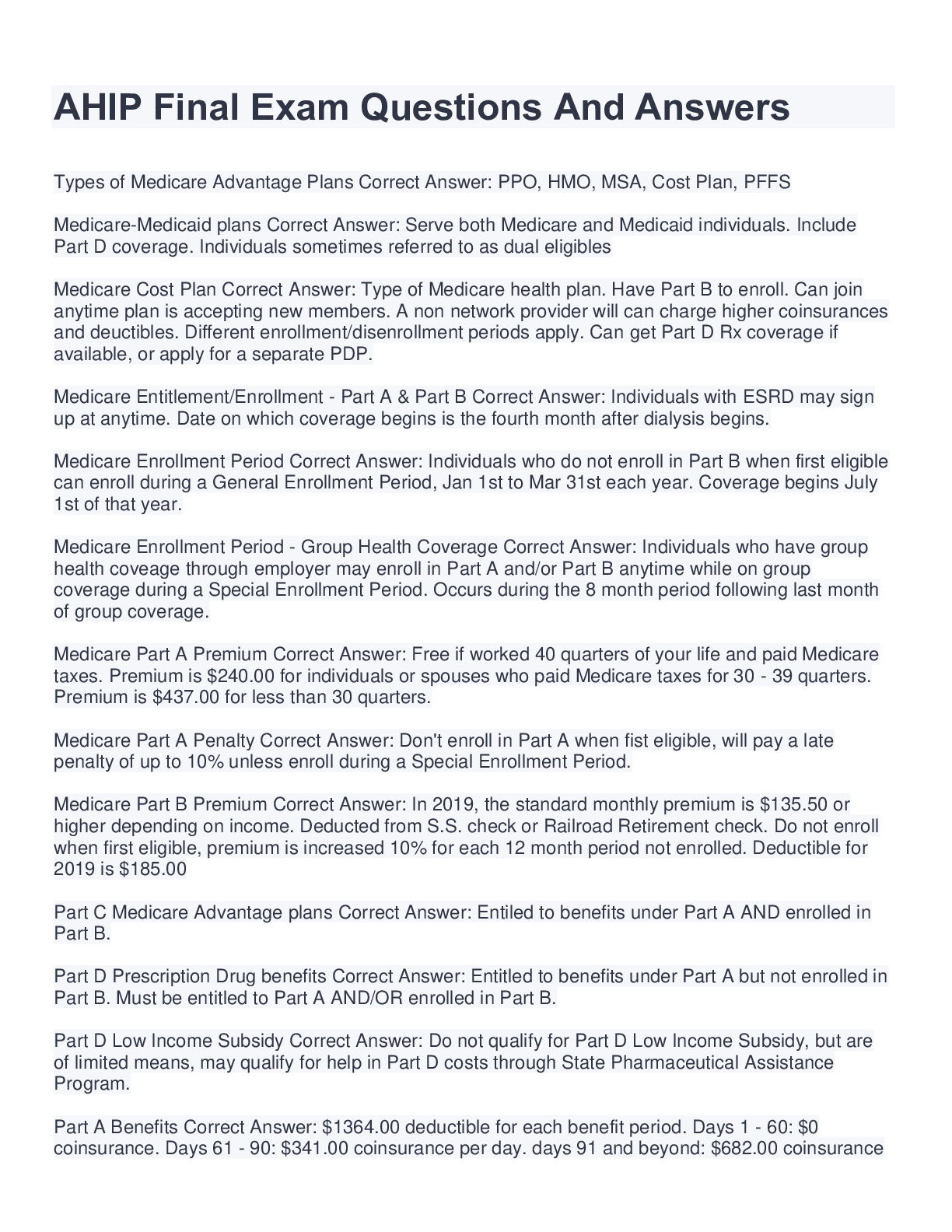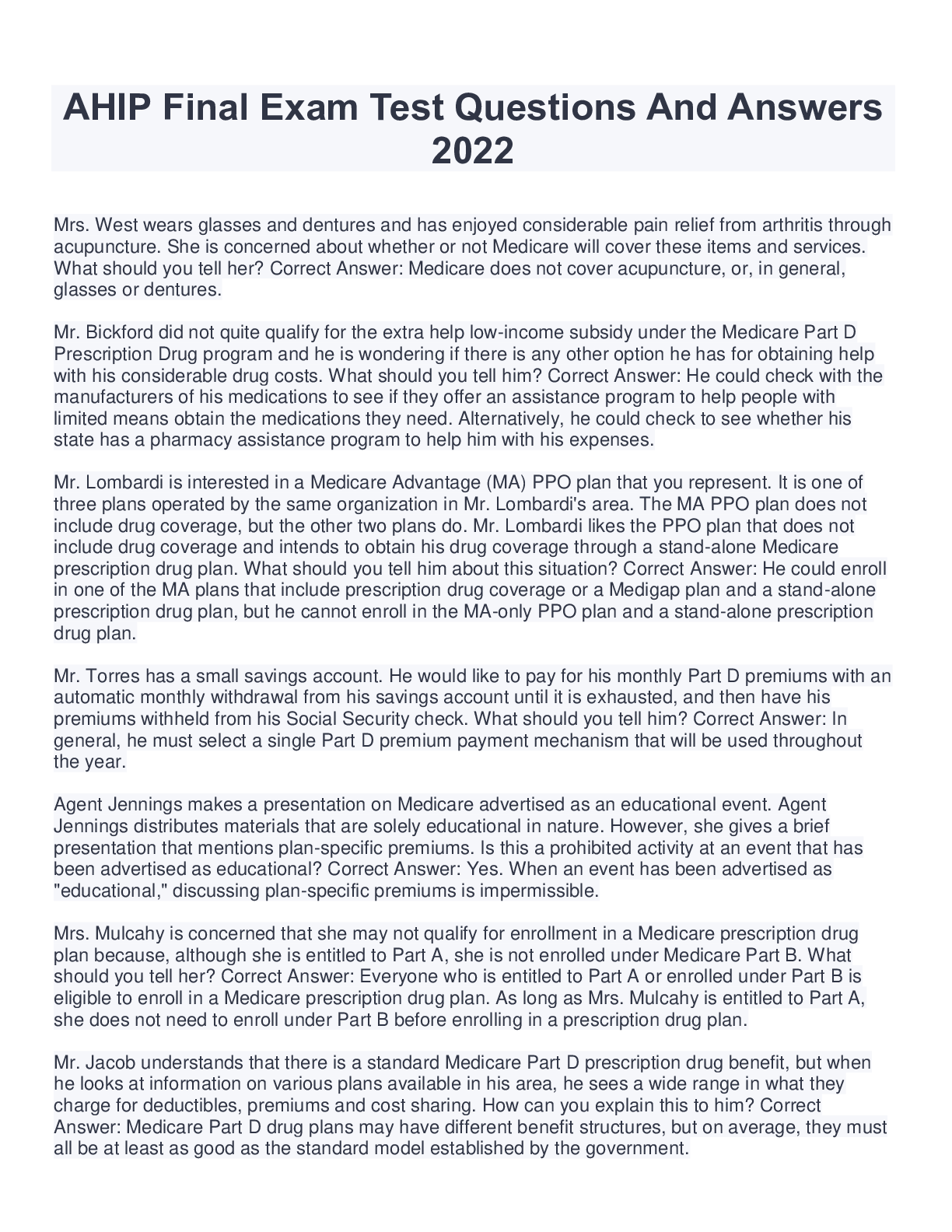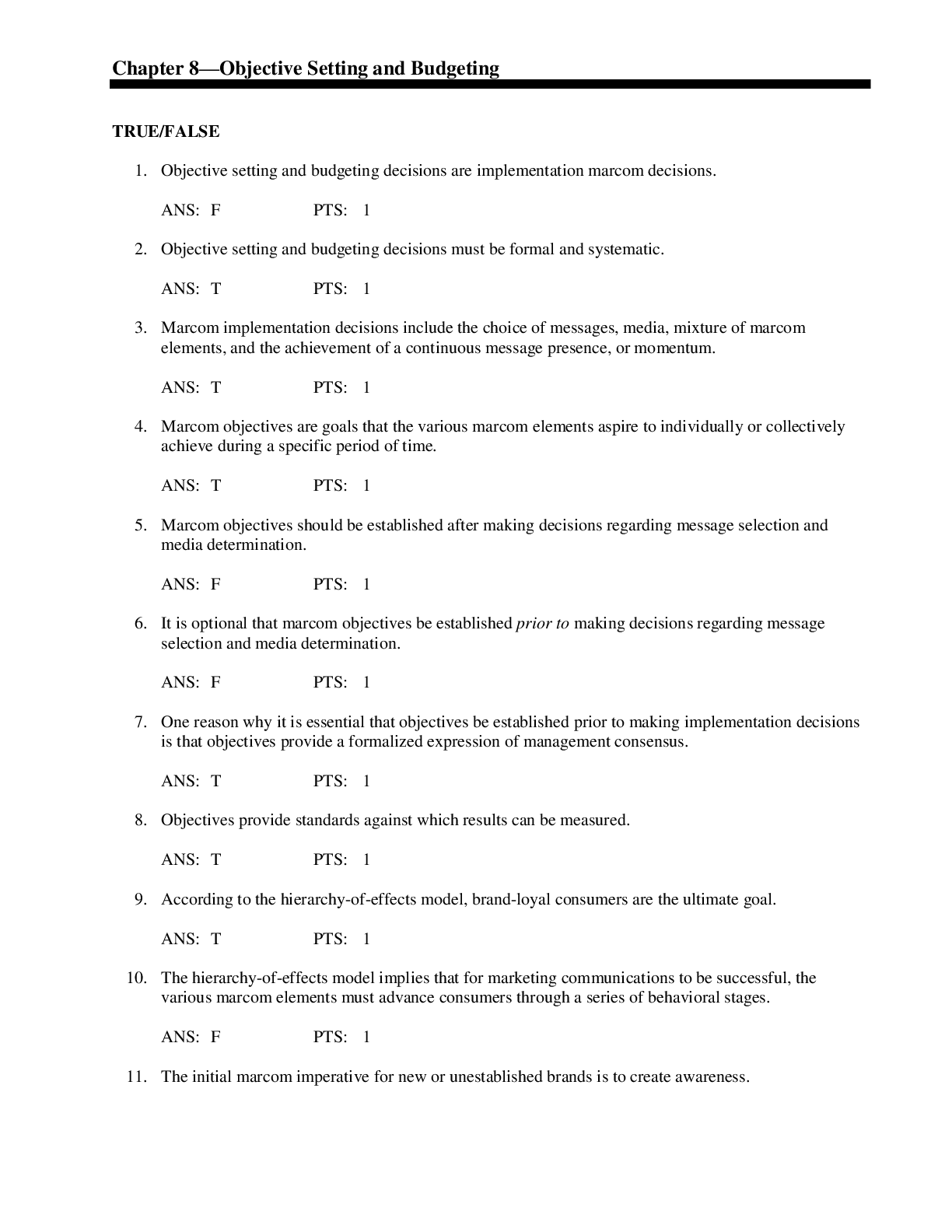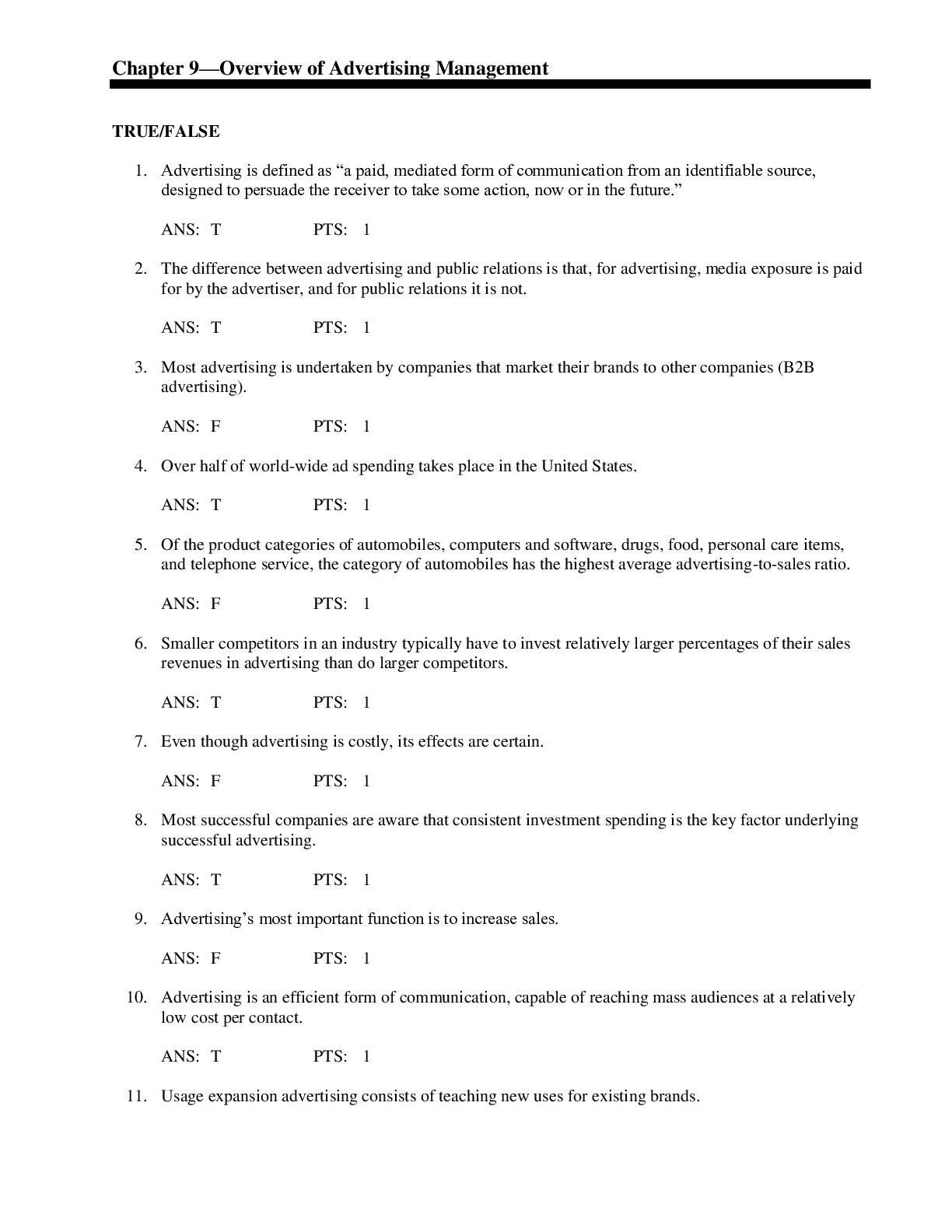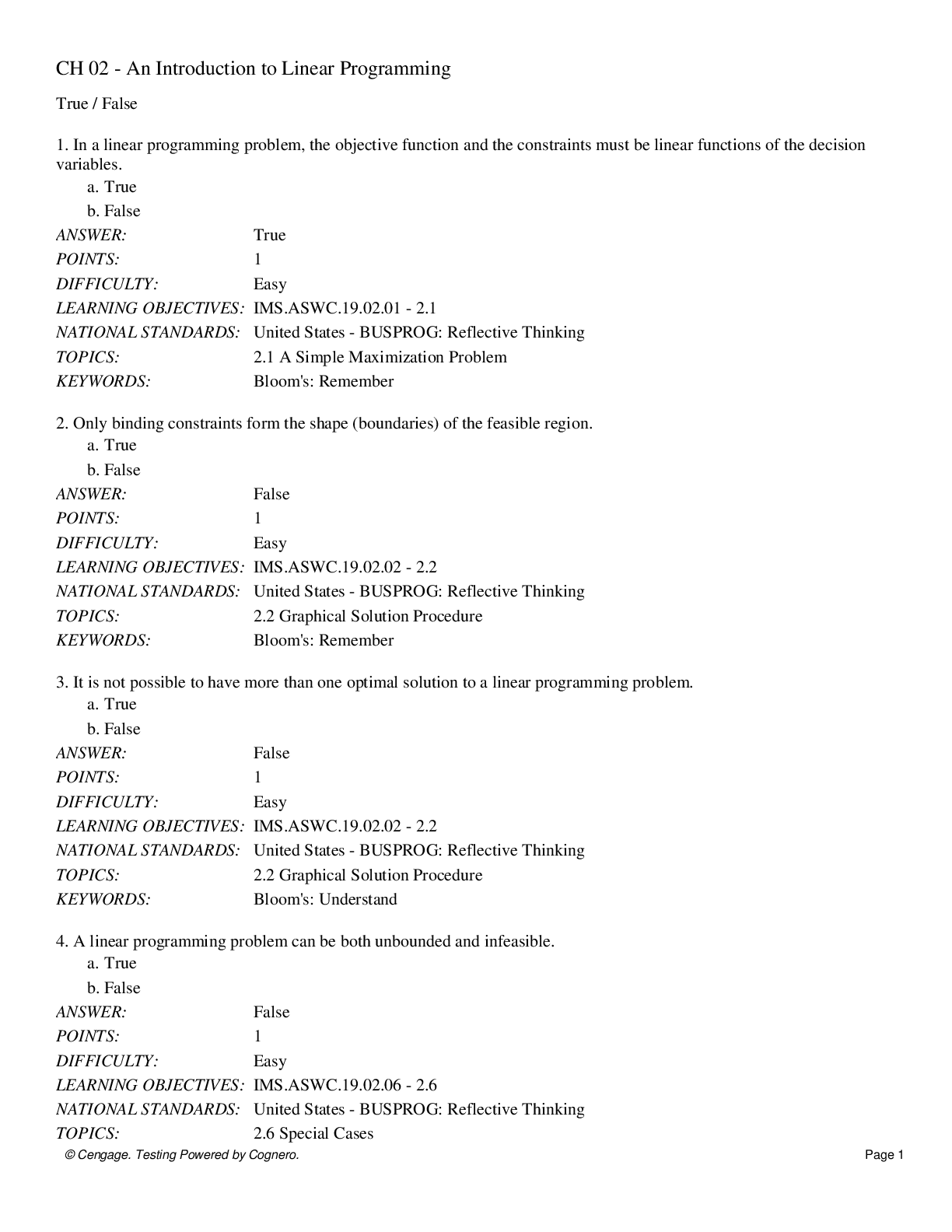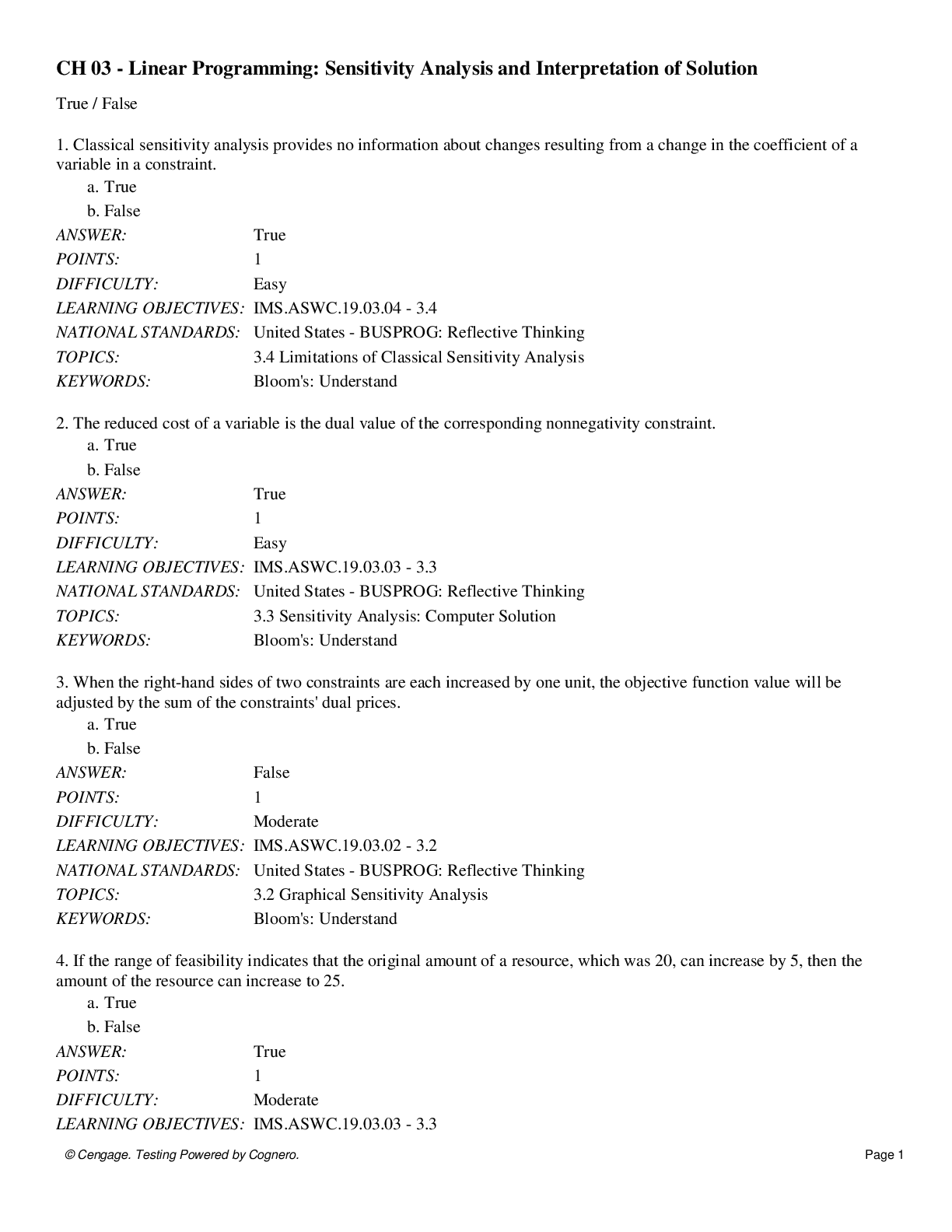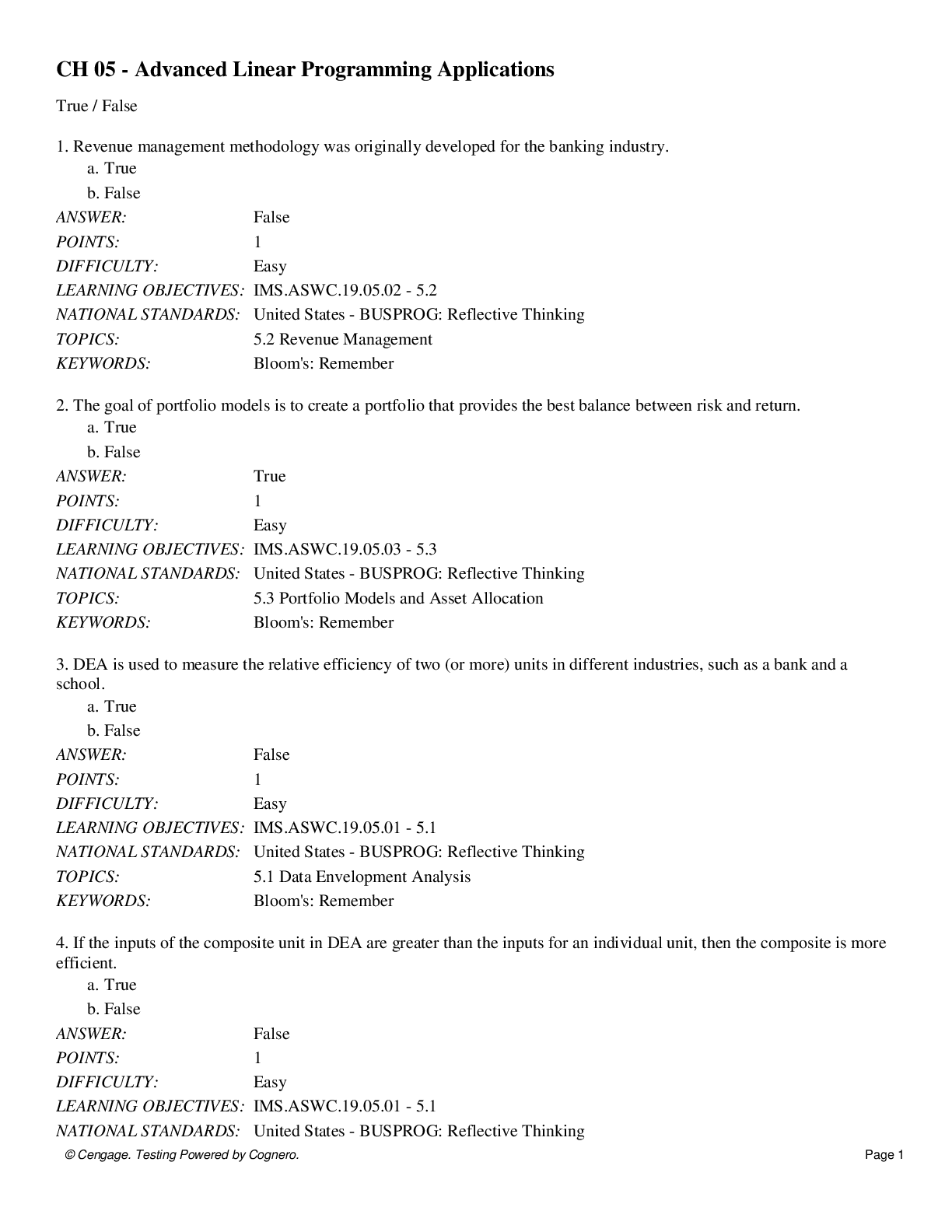Microeconomics > QUESTIONS & ANSWERS > BUSINESS BUSC 1B MICRO ECONOMICS QUESTIONS AND ANSWERS 2021 GRADED A+ (All)
BUSINESS BUSC 1B MICRO ECONOMICS QUESTIONS AND ANSWERS 2021 GRADED A+
Document Content and Description Below
BUSINESS BUSC 1B MICRO ECONOMICS QUESTIONS AND ANSWERS 2021 GRADED A+ Multiple Choices Identify the choice that best completes the statement or answers the question. 1. Which of the followi... ng illustrates the law of demand? a. Jorge buys fewer pencils at $2 per pencil than at $1 per pencil, ceteris paribus. b. Chen buys more ice cream at $4 per half-gallon than at $3 per half gallon, ceteris paribus. c. Karissa buys fewer sweaters at $50 each than at $35 each, ceteris paribus. d. a, b, and c e. a and c 2. At a price of $15 each, Marta buys 4 books per month. When the price increases to $20, Marta buys 3 books per month. Luz says that Marta's demand for books has decreased. Is Luz correct? a. Yes, Luz is correct. b. No, Luz is incorrect. Marta's demand has increased. c. No, Luz is incorrect. Marta's quantity demanded has decreased, but her demand has stayed the same. d. No, Luz is incorrect. Marta's quantity demanded has increased, but her demand has stayed the same. e. No, Luz is incorrect. Marta's quantity demanded has decreased and her demand has increased. Exhibit 3-4 3. Refer to Exhibit 3-4. A price of $6 in the market will result in a a. shortage of 10 units. b. surplus of 10 units. c. surplus of 5 units. d. shortage of 5 units. 4. Refer to Exhibit 3-4. At a price of $2 _______________ units will be exchanged. a. 5 b. 10 c. 15 d. 20 5. Refer to Exhibit 3-4. At a price of $6 _______________ units will be exchanged. a. 5 b. 10 c. 15 d. 20 6. Refer to Exhibit 3-4. A price of $2 in the market will result in a a. shortage of 10 units. b. surplus of 10 units. c. surplus of 5 units. d. shortage of 5 units. Exhibit 3-6 7. Refer to Exhibit 3-6. If an increase in income causes the demand for good X to shift from D1 to D3, then good X is a. a normal good. b. an inferior good. c. a substitute good. d. a complementary good. e. a neutral good. 8. Refer to Exhibit 3-6. If a decrease in income causes the demand for good X to shift from D1 to D2, then good X is a. a normal good. b. an inferior good. c. a substitute good. d. a complementary good. e. a neutral good. 9. Refer to Exhibit 3-6. If an increase in income causes the demand for good X to shift from D1 to D2, then good X is a. a normal good. b. an inferior good. c. a substitute good. d. a complementary good. e. a neutral good. 10. Refer to Exhibit 3-6. If an increase in the price of good Y causes the demand for good X to shift from D1 to D2, goods X and Y are a. normal goods. b. inferior goods. c. substitutes. d. complements. e. neutral goods. 11. Refer to Exhibit 3-6. If D1 is the relevant demand curve, an increase in the price of good X may cause a. demand to shift from D1 to D2. b. demand to shift from D1 to D3. c. a movement along D1 from point A to point B. d. a movement along D1 from point A to point C. Exhibit 3-7 12. Refer to Exhibit 3-7. If S1 is the relevant supply curve, a decrease in the price of a resource that is necessary for the production of good X causes a. the supply of good X to shift from S1 to S2 b. the supply of good X to shift from S1 to S3. c. a movement along S1 perhaps from point A to point B. d. a movement along S1 perhaps from point A to point C. e. no change in the supply of good X. 13. Refer to Exhibit 3-7. If S1 is the relevant supply curve, an increase in the price of good X may cause a. the supply of good X to shift from S1 to S2 b. the supply of good X to shift from S1 to S3. c. a movement along S1 perhaps from point A to point B. d. a movement along S1 perhaps from point A to point C. e. no change in the quantity supplied of good X. 14. Refer to Exhibit 3-7. If S1 is the relevant supply curve, a decline in technology in the production of good X causes a. the supply of good X to shift from S1 to S2 b. the supply of good X to shift from S1 to S3. c. a movement along S1 perhaps from point A to point B. d. a movement along S1 perhaps from point A to point C. e. no change in the supply of good X. Exhibit 3-16 15. Refer to Exhibit 3-16. Which of the graphs best represents the market for theater tickets that are already sold out on the day of the performance? a. (1) b. (2) c. (3) d. (4) 16. Refer to Exhibit 3-16. If there are empty seats for a basketball game at the price P*, the situation is best depicted on graph a. (1), with P* = P1. b. (2), with P* = P3. c. (3), with P* = P2. d. (3), with P* = P3. e. (4), with P* = P1. 17. Refer to Exhibit 3-16. Which of the following is false? a. Graph (1): There is a shortage of this good when the price is equal to P3. b. Graph (2): As supply increases, equilibrium quantity remains constant. c. Graph (3): As demand increases, equilibrium price remains constant. d. Graph (4): As supply changes, equilibrium price stays the same. 18. Which of the following statements best represents the law of supply? a. Price and quantity supplied are inversely related. b. Price and quantity supplied are directly related. c. Price and quantity supplied are inversely related, ceteris paribus. d. Price and quantity supplied are directly related, ceteris paribus. e. Price and supply are directly related, ceteris paribus. 19. What is the definition of producers’ surplus? a. price received minus maximum selling price b. maximum selling price minus price received c. price received minus minimum selling price d. highest price minus lowest price e. none of the above 20. A price ceiling is a government-mandated a. minimum price below which legal trades cannot be made. b. maximum price above which legal trades cannot be made. c. minimum price above which legal trades cannot be made. d. maximum price below which legal trades cannot be made. 21. A price floor is a government-mandated a. minimum price below which legal trades cannot be made. b. maximum price above which legal trades cannot be made. c. minimum price at which all units of the good must be legally sold. d. minimum price below which legal trades can be made. 22. There are two goods in the economy, apples and bread. The relative price of apples has increased. This could be due to a. an increase in the absolute price of apples, ceteris paribus. b. a decrease in the absolute price of bread, ceteris paribus. c. a decrease in the absolute price of apples, ceteris paribus. d. an increase in the absolute price of bread, ceteris paribus. e. a and b 23. If the absolute price of a new car is $40,000 and the relative price of a laptop computer in terms of cars is 1/20 of a car, it follows that the absolute price of a laptop is a. $10,000. b. $1,000. c. $4,000. d. $2,000. e. There is not enough information to answer the question. Exhibit 4-6 24. Refer to Exhibit 4-6. At a wage of $7, there will be a __________ of unskilled workers equal to __________ thousand workers. a. shortage; 10 b. surplus; 20 c. surplus; 10 d. shortage; 20 e. surplus; 15 25. Refer to Exhibit 4-6. Suppose the minimum wage is set at $7. The result will be a. a surplus of unskilled workers. b. a shortage of unskilled workers. c. no effect on the market for unskilled labor. d. none of the above 26. Refer to Exhibit 4-6. Suppose the minimum wage is set at $5. The result will be a. unemployment. b. a shortage of unskilled labor. c. no effect on the unskilled labor market. d. a prolonged surplus of unskilled labor. e. none of the above Exhibit 4-7 27. Refer to Exhibit 4-7. The number of unskilled workers who want to work at the minimum wage is a. N3. b. N1. c. N2. d. N2 - N1. 28. Refer to Exhibit 4-7. How many fewer persons work in the unskilled labor market at the minimum wage (WM) than at the equilibrium wage (W1)? a. (N2 - N1) persons b. (N1 - N3) persons c. (N2 - N3) persons d. N3 persons e. none of the above 29. Refer to Exhibit 4-7. How many unskilled workers are employed at the minimum wage? a. N2 b. N1 c. N3 d. N1 + N3 Exhibit 4-8 30. Refer to Exhibit 4-8. Suppose that wheat producers lobby the government for a price floor and receive one. This price floor is set at PF. What has happened to the producers’ surplus as a result of the imposition of the price floor? a. Producers’ surplus has risen by (area 2 + 3) b. Producers’ surplus has fallen by (area 4 + 5) c. Producers’ surplus has changed by (area 3 - area 5) d. Producers’ surplus has changed by (area 2 - area 5) 31. Refer to Exhibit 4-8. Suppose that wheat producers lobby the government for a price floor and receive one. This price floor is set at PF. What is the size of the total surplus at PF? a. area 1 + 2 + 3 b. area 1 + 2 + 3 + 4 c. area 1 + 2 + 3 + 4 + 5 d. area 1 + 2 + 3 + 4 + 5 + 6 32. Refer to Exhibit 4-8. If the wheat market is in competitive equilibrium the total surplus will equal a. area 1 + 2 + 3 + 4 + 5 b. area 1 + 2 + 3 c. area 2 + 3 + 4 + 5 d. area 4 + 5 33. Price elasticity of demand is a measure of the responsiveness of quantity demanded to changes in a. interest rates. b. price. c. supply. d. demand. 34. If quantity demanded rises by 10 percent as price falls by 9 percent, the price elasticity of demand equals a. 0.90. b. 1.11. c. 0.09. d. 0.19. 35. If the cross elasticity of demand for good A with respect to good B is -0.87, then good A is a. an inferior good. b. a normal good. c. a substitute for good B. d. a complement to good B. Exhibit 20-1 __D__ 36. Refer to Exhibit 20-1. The demand curve D1 is a. inelastic. b. elastic. c. unit elastic. d. perfectly elastic. e. perfectly inelastic. 37. Refer to Exhibit 20-l. The demand curve D2 is a. inelastic. b. elastic. c. unit elastic. d. perfectly elastic. e. perfectly inelastic. 38. Refer to Exhibit 20-l. The demand curve D3 is a. inelastic. b. elastic. c. unit elastic. d. perfectly elastic. e. varying in elasticity along its length. 39. If the demand for a good is unit elastic and the price of the good increases, then a. total revenue increases. b. total revenue decreases. c. total revenue is not affected. d. the direction of the change in total revenue cannot be determined from the information given. Exhibit 20-5 40. Refer to Exhibit 20-5. Assume that the seller of X increases the price from $1.50 to $2.00, and this results in an increase in total revenue. Which of the graphs represents the demand curve for X? a. (1) b. (2) c. (3) d. all of the above 41. Refer to Exhibit 20-5. For graph (3), if the seller of X raises the price from $1.50 to $2.00, the total revenue the seller receives will a. decrease by $30. b. increase by $30. c. decrease by $5. d. not change. 42. Refer to Exhibit 20-5. For graph (1), what is the price elasticity of demand going between $2.00 and $1.50? a. 0.02 b. 0.43 c. 2.33 d. 42.8 43. Refer to Exhibit 20-5. For graph (3), what is the price elasticity of demand going between $2.00 and $1.50? a. 1.0 b. 0 c. 50.0 d. 0.02 44. If total revenue rises as a result of a decrease in price, it follows that demand is a. inelastic. b. perfectly inelastic. c. elastic. d. unit elastic. e. none of the above True/False Indicate whether the statement is true or false. 45. Mutually beneficial trade between buyers and sellers drives a market to equilibrium. 46. In general, all markets equilibrate at the same speed. 47. A deadweight loss is the loss to society of not producing the supply-and-demand determined level of output. 48. A tax placed on a good can make that good relatively more expensive and its substitutes relatively less expensive. 49. Price elasticity of demand is the ratio of the percentage change in price of a good to the percentage change in quantity demanded of that good. 50. It is impossible for a good to be price elastic in demand and price inelastic in supply. Essay 51. Suppose that the average price of refrigerators has fallen over the past few years, yet the refrigerator companies have offered more and more of them for sale. Does this mean that the supply curve for refrigerators is downward sloping? Explain. 52. Explain why it is important to differentiate between the "number of unskilled workers" and the "number of unskilled labor hours" when evaluating the impact on the market for unskilled labor of a change in minimum wage. 53. Provide an economic explanation for why many companies hire celebrities to advertise their products. Be sure to include a discussion of the possible impact of celebrity endorsements upon the price elasticity of demand and total revenue for the product being advertised. . [Show More]
Last updated: 1 year ago
Preview 1 out of 12 pages
Instant download

Buy this document to get the full access instantly
Instant Download Access after purchase
Add to cartInstant download
Reviews( 0 )
Document information
Connected school, study & course
About the document
Uploaded On
Dec 30, 2020
Number of pages
12
Written in
Additional information
This document has been written for:
Uploaded
Dec 30, 2020
Downloads
0
Views
63


